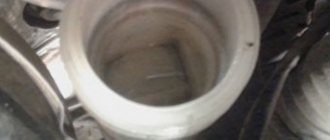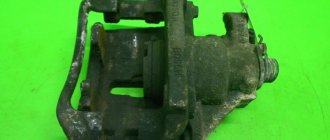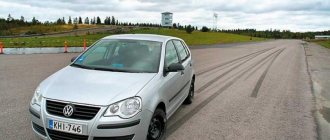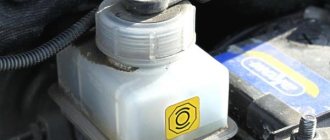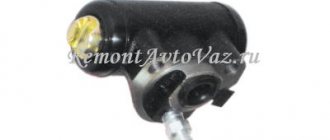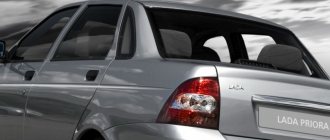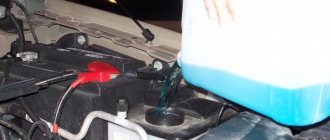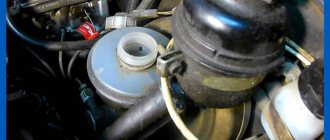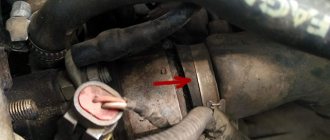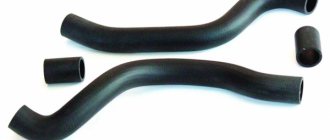Anti-lock braking system ABS: types, types
Depending on the type and type, ABS is classified into:
- One scheme of operation of the ABS system is when all the devices that make up the ABS are located in one unit. That is, the hydraulic valve block, hydraulic accumulator and pump are located in one unit.
- The second ABS scheme is when the component devices (hydraulic valve block, hydraulic accumulator and pump) are located in different places. In this type of braking system, in addition to the ABS module, there is also an ESP module and an SBC module.
Whether you can bleed the brake system yourself depends on what type of brake system is in your car.
If the car has a system of the first type, then it is easy to properly pump the ABS.
If the car has a system of the second type, then one cannot cope without a scanner; it needs to be pumped to a service center for maintenance.
The ABS system consists of:
- Sensors (installed on the hubs). When replacing rear wheel hubs, as well as some front ones, you may notice special recesses for sensors. They are engaged in transmitting data about the speed of movement.
- Control valves (installed in the brake system). Serve to change the pressure in the system.
- The electronic unit. Receives speed information from sensors and adjusts control valves.
Replacing brake fluid at Granta
| The manufacturer recommends changing the brake fluid in the hydraulic brakes of the Lada Granta after 3 years of operation or 45 thousand km. mileage (whichever comes first). As a rule, this procedure is performed at a service station, but if you wish, you can service the VAZ 2190 brakes yourself. |
You will need : an “8” wrench for the pipeline nuts, brake fluid, a rubber or transparent hose, a transparent container, a syringe or a rubber bulb.
For reference: Brake fluids used in the hydraulic brake drive system:
| ROSDOT | Tosol-Sintez LLC, Dzerzhinsk | TU 2451-004-36732629 |
| KAPROS-DOT | Sibur-Neftekhim LLC, Dzerzhinsk | TU 2451-030-52470175 |
ABS bleeding sequence
- First, we look for and remove the fuse in the fuse block that is responsible for the operation of the anti-lock braking system.
- Next, we jack up and remove one front wheel, and look for the brake wheel cylinder (BWC) fitting.
- After this, we put a hose on the fitting (from a hydraulic level, for example).
- Open the fitting one turn.
- One presses the brake pedal all the way and holds it in that position.
- Now turn the ignition key to turn on the hydraulic pump (the ABS indicator lights up on the instrument panel).
- The second person watches how air is removed through the hose and, after removing the air, tightens the fitting.
- We release the brake pedal only after tightening the fitting.
- Now, how do you know that all the air has escaped from the ABS? This shows the ABS icon on the dashboard, if it goes out after removing the air and tightening the fitting, then all the air has escaped.
The correct sequence for bleeding the ABS system
There is a special order for properly bleeding an anti-lock brake system: right front wheel, then rear, then rear right, and then rear left wheel. If during such work the fuel fluid leaks out of the system, it is necessary to fill the system with new fluid. And to do this, you need to know what fluids can be mixed and how much brake fluid is needed to replace.
Replacing brake fluid on Kalina
Welcome! Brake fluid - although it is called brake fluid, in some cars, namely in classics and Nivas, it is also used in the clutch mechanism, and all this is because on these cars the clutch mechanism and the brake mechanism work according to the same principle, but on front-wheel drive, the clutch is no longer engaged due to the fluid, but due to the cable that comes from the pedal and is connected to the box, but we are now talking about the brakes and not the clutch, we will try to explain to you why this particular fluid is present in the brake system, that’s all the fact is that this liquid is not compressed and therefore when you press the pedal, the rod, which is located in the main brake cylinder, moves forward and in connection with this the liquid moves and all the pistons on four wheels push the brake pads and thus braking occurs if If you are interested, you can learn more about this from the article entitled: “The principle of operation of the brake caliper and why is it needed?”
Note! To carry out the procedure for changing the fluid on your car, you will need: Firstly, the new brake fluid itself, secondly, a set of wrenches, and also a thin hose will need a suitable diameter, namely one that will fit onto the fitting when bleeding (If you don’t know nothing about this fitting, then don’t change the fluid yet, but at the beginning just read the article in detail and you will understand what we are talking about, then using this fitting you will select a thin hose for bleeding), and the container itself is 1-2 empty liters will be needed in order to drain all the old fluid from the system into it!
Summary:
Where is the brake fluid located? This fluid is located in the brake hoses, as well as in the brake master cylinder, the main part of it is located, and the most important part is located in the brake reservoir, which is indicated below in the diagram as number 8, by the way, in the diagram below, arrow number 4 indicates the brake master cylinder, arrows 3 , 7, 18, 11 the brake hoses are indicated, and in general the entire diagram shows the brake system of the car, you can understand a lot from it and most importantly, if you think a little, you can understand the principle of its operation, remember we said at the beginning that you don’t compress the liquid, so let’s explain in a nutshell, when you press the brake pedal (indicated by number 10), the rod that is located in the main brake cylinder moves forward, due to the fact that the liquid is not compressible, it presses on the working brake cylinders, which are in the brake the calipers are located (the calipers are indicated by numbers 1 and 5, in the rear there are no calipers, purely working brake cylinders are located there, one of them is clearly visible and is indicated under the number 16) and they, in turn, push out the brake pads, and this is how the car is braked, the fluid By the way, it is constantly in the brake pipes, due to the fact that it is filled into the brake reservoir.
When should you change your brake fluid? From time to time and only from time to time, but although if you are repairing the brake mechanism and this repair will affect the brake fluid, then in this case you will need to buy one new bottle, because as a rule, when work is carried out on the brake system, it itself is affected brake fluid (For example, you disconnect the brake hose from the caliper and then close the hose with a plug so that the fluid does not spill out of it, but in this case it will still be affected) air particles get into it, due to which the fluid begins to shrink (And this is unacceptable, otherwise the car will brake poorly or will not do this at all) and therefore, in order to expel this air from the system, you will have to drain some fluid and fill it with new one, in addition, the fluid must be completely replaced in the case when its expiration date will expire (Each liquid has its own expiration date and it is indicated on the box, so when you buy a new liquid, look at the manufacturing date it has and also pay attention to the expiration date, it is usually about 3, 5 years) and after 2-3 years after filling, because when the fluid is poured into the brake system it begins to slowly absorb moisture, in 2 years it will begin to consist of 3-4 percent moisture, which is very bad and due to with this, the effectiveness of the brakes will disappear and, most importantly, it will boil faster, for example, new brake fluid (let’s take DOT-4, it’s just that everyone boils differently and therefore we will be determined by a specific fluid) boils at a temperature of 230-240 degrees, the old one is 2 years old -3 which and which has absorbed moisture will boil already at a temperature of 160-170 degrees and you can forget about the effectiveness of the braking system while it is boiling for a while (Until it cools down).
Note! The fluid also needs to be replaced when its color changes (But not all fluids are colored, basically all brake fluids are transparent) or if it is very dirty, for example, you bought the fluid and drove it for two years and look into the reservoir and it’s all cloudy, sediment is visible at the top or at the very bottom, in this case the liquid must be replaced immediately and there is no need to delay with it, because the sediment and dirt in the liquid already indicates that it has begun to deteriorate and the more time passes, the worse it will be!
Conclusion
After carrying out repair and maintenance work on critical components of the car, before driving, you must first check the tightness of the system and the operability of the vehicle components.
ABS - Anti-lock Braking System is a system against wheel locking during heavy braking. Thanks to the fact that ABS prevents the car from skidding along the road, safety increases in emergency situations. The anti-lock braking system will operate correctly if the system is not air-filled.
Watch this helpful video. Tests show that even a working ABS system turns off at the end of the braking distance, so you still need to modify it with your foot.
Bleeding the Brakes Main Section If there has been a brake fluid leak or if air has entered the system, the system must first be cleared before proceeding further. Place the car on a level surface, start the power unit and engage first gear or reverse gear on models with a manual transmission (on models with an automatic transmission, place the selector lever in the “P” position). After this, place the bars under the wheels and turn off the handbrake. Bleeding air from the brake system If the fault is in only one circuit of the hydraulic system (it has a diagonal branch on samples without ABS and a front and rear branch on samples with ABS), then bleeding will only be necessary in the corresponding circuit. In the case of the main brake cylinder (its disconnection or connection), if the brake fluid level has dropped significantly, it is necessary to remove air from the entire system, observing the following sequence.
For models without ABS system: a) right front brake; b) right rear brake; c) left front brake; d) left rear brake.
How to bleed the brakes alone
As a rule, it is much more convenient to bleed the brakes with two people. If this is possible, it is better to immediately invite an assistant, as the process is noticeably simplified. If there is no assistant, you can bleed the brakes yourself.
To do this, you use a gas stop (for example, a hood gas stop), as well as basic rules on how to bleed the brakes.
- After adding brake fluid to the master cylinder reservoir to the “maximum” level, press the brake pedal all the way several times.
- Next, the gas stop is placed between the seat and the brake pedal.
- Now you can bleed the brake fluid with air bubbles from the cylinders on the wheels according to the standard procedure.
We also recommend reading the article on how to check the ABS sensor on a car. In this article, you will learn about the symptoms of a malfunction, as well as the available methods for checking ABS sensors.
In this case, the gas stop constantly presses on the pedal, which makes it possible to do without an assistant. The main thing is that when pumping the brake cylinders on each wheel, you should constantly monitor the level of brake fluid in the reservoir. If the level drops, topping up is necessary.
2283-4-22-04 (Copy)
It is necessary to bleed the brake system hydraulic drive until new fluid (lighter than the old one) begins to come out of the bleeder fittings of all working cylinders.
We carry out pumping to replace the fluid with the engine not running, first on one circuit, and then on the other in the following sequence:
- right rear wheel brake;
- left front wheel brake mechanism;
- left rear wheel brake;
- brake mechanism of the right front wheel.
Brake fluid composition
Brake fluid comes in different types, but is usually made from a low-viscosity solvent, such as alcohol, and a viscous, non-volatile substance, such as glycerin.
Brake fluid is produced based on polyethylene glycol under the brands DOT 3, DOT 4 and DOT 5.1.
Based on silicone – silicon-organic polymer products grade DOT 5.
For vehicles with an anti-lock braking system, DOT 5.1/ABS brake fluids based on silicone and glycols can be used. About brake fluids wiki: link.
2283-4-24-02 (Copy)
An assistant must vigorously press the brake pedal all the way 1-2 times and keep it pressed.
In this case, liquid will flow out of the hose, and the brake pedal should be pressed all the way.
As soon as the liquid stops flowing from the hose, tighten the fitting, and only after that can the assistant release the pedal.
We repeat this operation until new brake fluid (lighter than the old one) comes out of the fitting.
We remove the hose, wipe the bleeder fitting dry and put a protective cap on it.
Remove the protective cap from the brake bleeder fitting of the left front wheel.
We put a hose on the fitting, and immerse its free end in a container partially filled with working fluid.
How to remove air from the brake system
When servicing your car yourself, it is important to know how to bleed the brakes. Start pumping from the front right wheel, then pump the front left. Typically, you need to start from the farthest wheel to the closest one in relation to the master cylinder.
Bleeding the front circuit is carried out with the ignition off, and the terminal on the brake system reservoir must be removed.
- A transparent hose is put on the fitting, the other end of the hose is completely lowered into a small container filled with liquid.
- Next, the fitting is opened with an open-end wrench. Air bubbles are clearly visible through the transparent hose when pumping.
- The brake pedal is depressed and held until the air is completely released. Then the fitting is tightened at the moment when liquid flows without air. Now the pedal can be released.
Bleeding the rear wheels
As for bleeding the contour of the rear wheels, they need to be pumped with the ignition on. Press the pedal and turn the key to activate the hydraulic pump. Then you need to control the process of air release.
You also need to monitor the brake fluid level in the reservoir. If necessary, fluid must be added. Please note that the pump cannot be operated without liquid! Do not allow the level of brake fluid in the reservoir to drop. The pump must not run continuously for more than 90 seconds!
To bleed ABS brakes on the rear left wheel, you should pay attention to the following nuances:
- putting the hose on the fitting, the fitting itself is not completely unscrewed (unscrewing it 1 turn is enough);
- The brake pedal should not be depressed;
- Having activated the hydraulic pump, after the air has escaped, the pedal is pressed halfway;
- then you can tighten the fitting, release the brake pedal and wait until the pump stops;
- Now the ignition is turned off, after which you can connect the tank connector;
We also recommend reading the article about which brake pads are best to choose. From this article you will learn about the features of selecting brake pads for a car, as well as what to look for when choosing brake pads for a car.
After bleeding the ABS brakes is completed, it is necessary to separately check the tightness of the brake system. Brake fluid leaks, brake pedal dips, very hard pedals, etc. are not allowed. You also need to additionally check the brake fluid level in the reservoir, adjusting it if necessary.
What is the difference between bleeding brakes with ABS and without ABS?
Bleeding the brakes on a car with ABS is not an easy task, and the problem is not the complexity of the pumping process itself, but rather a lack of awareness. Bleeding brakes on a vehicle with ABS and without an anti-lock braking system differs significantly in some key points and has its own characteristics.
Three main differences between an anti-lock braking system and a conventional brake:
- In an ABS system, unlike non-ABS brakes, the piping system (the rear wheel circuit) is under increased pressure.
- The presence of an anti-lock braking system requires regular monitoring of the brake fluid level. If its level is at an extremely low level, the drive pump runs dry and begins to pump only air, thereby quickly stopping functioning.
- The operating time of the pump should not exceed two minutes, but if it has worked longer, it is necessary to turn on the ignition for ten minutes to cool it down.
Preparing for work
It is good to pump ABS brakes on an overpass or pit . Bleeding brakes with ABS, like bleeding a conventional brake system, is carried out with an assistant, starting the process of bleeding the brake system from the front wheels, then the rear (right and left). Shortly before starting work, it is recommended to inspect the threads of the brake bleeding fitting, for a smooth process: bleeding brakes
But first you need to determine what type of ABS system you have:
- If there is a simple ABS system, when all the components are in one housing, then it is enough to simply find the fuse, which in most cases is located in the system block. If you remove the fuse, the ABS system will be completely disabled. If you turn on the ignition, a light will come on, indicating that the ABS is faulty.
- Next, in the engine compartment, you need to find the cap on the expansion tank of the brake system and unscrew it. Before doing this, it is better to remove the connector from the electrical sensor.
- Then you need to look under the car, and near each wheel, find fittings for bleeding the working cylinders and loosen them. Here you need to make sure that the descenders do not break, because if they break, the work will take a long time. You can pre-treat the fittings with brake fluid or WD-40.
- In order to do the work accurately and at the highest level, you need to stock up on a flexible, clean hose whose internal diameter will be the same as the size of the fitting. And you need to pour about a third of the brake fluid into the bottle. By the way, you can buy brake fluid here: https://chaspik.org.ua/teh-jidkosti/tormoznyie-jidkosti/.
Brake fluid compatibility
For topping up, you can use liquid from the same manufacturer, but subject to the following principles:
- Only liquid with a higher rating number can be added, that is, DOT 3 can be filled with DOT 4, and DOT 4 can be filled with DOT 5.1.
- Do not mix DOT 5 with other brands - DOT 3, DOT 4, DOT 5.1.
- Do not mix mineral (e.g. LHM+) and glycol fluids.
If you break the rules, this will lead to a serious change in the characteristics of the liquid for the worse.
Characteristics and properties of brake fluid
In order for the brake system to function properly, the brake fluid must have certain characteristics and meet quality standards.
Boiling temperature . New brake fluid does not contain moisture, so its boiling point is within acceptable limits. But over time, moisture from the surrounding air enters the fluid, usually 1-2% per year of the total volume, but the characteristics of the brake fluid begin to change.
During braking, the working fluid heats up to very high temperatures due to friction. At this point, it is very important that the brake fluid does not boil, since in this case the moisture evaporates from the liquid in the form of steam. And steam is dangerous because it is easily compressible and the next time you brake, the pressure on the brakes will be less, since part of the volume will be taken away by the compressible steam.
The boiling point of brake fluid directly depends on the amount of water in it. The more water, the lower the boiling point and the greater the chance of “losing” the brakes.
Hygroscopicity . Some brands of “brake guards” have minimal hygroscopicity (moisture absorption), for example, DOT 5 and can maintain the necessary characteristics throughout their service life. But the most common brands DOT 3, DOT 4 and DOT 5.1 gradually lose their properties due to the increasing amount of moisture in them.
Viscosity _ This characteristic will determine how the brake fluid will be pumped throughout the system. And it should pump well both at -30 degrees Celsius and at 200 degrees, during braking.
If the fluid freezes completely or in places, it blocks the brakes. Fluid that is too thick will have difficulty pumping throughout the system, which will lead to either poor braking or different forces on different wheels. Too liquid will lead to leaks.
Corrosion protection . The brake fluid itself acts as a protection against corrosion within the brake system. In this case, protection should be ensured even with small amounts of moisture inside the system.
Corrosion protection is provided by special additives. They also provide protection for the sealing elements.
Compressibility . Ideally, brake fluid should not compress at all, but there are certain tolerances for this characteristic. The main thing is that the liquid works equally well under different temperature conditions.
| “Dry” boiling point, °C | “Wet” boiling point (3.5% water), °C | Viscosity, mm 2 /s | Main components | |
| DOT 2 | 190 | 140 | — | Castor oil/alcohol |
| DOT 3 | 205 | 140 | 1500 | Glycol |
| DOT 4 | 230 | 155 | 1800 | Glycol/Boric acid |
| LHM+ | 249 | 249 | 1200 | Mineral oil |
| DOT 5 | 260 | 180 | 900 | Silicone |
| DOT 5.1 | 260 | 180 | 900 | Glycol/Boric acid |
Security measures
To prevent brake fluid from oxidizing, evaporating, or picking up moisture, it must be stored in an airtight container.
As a rule, they are flammable, so they must be kept away from open flames and high temperatures.
They are poisonous, it is recommended to work with gloves, although there will be no obvious signs of burns if they come into contact with the skin.
Under no circumstances should you drink, even a small amount will lead to poisoning. If liquid gets into your eyes, rinse them thoroughly with clean water and consult a doctor.
Why does the brake pedal fail after replacing the pads?
To understand why this happens, you need to remember the structure of the braking system. The simplest system, which lacks ABS, pressure regulators and other “additional” elements, works quite simply. When you press the brake pedal, the master cylinder with a vacuum booster is activated. As a result, the pressure in the main pipe and hoses increases, and the fluid activates the brake system.
Having analyzed the operation of the brake system, we can conclude that the pedal fails in two cases: when the required amount of brake fluid is missing or air enters the system, that is, depressurization occurs. There are several main reasons that lead to the problem in question after replacing brake pads:
Damage to the cylinders. The most common cause of brake system depressurization is physical damage to the cylinders. On the working cylinder, to prevent air from entering the system (as well as to retain brake fluid in it), there is a special rubber element - a cuff. If the pads are replaced carelessly, this element may be damaged, resulting in depressurization of the system, and the brake will fail when pressed;
- Low amount of brake fluid. If there is little fluid left in the brake system, the brake pedal will sink when pressed. When not only replacing pads, but also other work, for example, working on stuck brake cylinders, the fluid level in the system may decrease due to pumping. If you do not add new fluid, the brake pedal will sink when pressed;
- Assembly problems. If, after replacing the brake pads, the system elements were assembled incorrectly, the pedal may fail when pressed. This is due to the fact that not only the piston of the working cylinder, but also the spring located on the caliper is responsible for returning it to its original position. If you forget to put it back in place, the pedal will remain depressed when pressed, reluctantly returning back.
Most often, the problem with the fact that the pedal fails after replacing the pads is due precisely to the inattention of the craftsmen performing the work. For example, if you press the brake pedal with the pads removed, not only will air enter the system, but fluid will also come out of it, and the calipers will also be squeezed out. This will lead to the fact that after replacing the pads the pedal will begin to sink when pressed.
